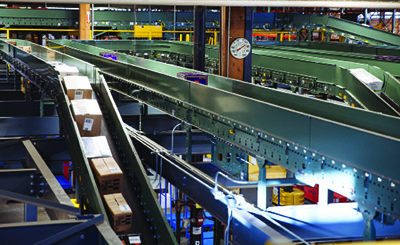Automation decreases liquor control commission’s shipping time
The distilled spirits distributor’s fully automated solution has increased its shipments by nearly 500 cases per hour.

Founded in 1933 at the end of the Prohibition Era, the Oregon Liquor Control Commission (OLCC) is currently the state’s sole distributor for distilled spirits, as it serves more than 260 liquor stores. So, with its sights set on previously unattainable shipping numbers, OLCC decided to expand its main facility, located in Portland, Ore.,—the company’s most ambitious development yet.
“Our system, in the past, was a linear conveyor system, which meant we could only ship out of one door at a time and were very limited to the amount of volume we could do per day,” says Barbara Feathers, manager of distribution operations.
“With our old system, we could run between 960 and 1,000 cases an hour. We were moving into the next day with the volume we had,” Feathers adds. “So we had to look at something that would shorten our working hours and increase our shipping capacity to double at its peak.”
The integration team worked closely with the OLCC to design a system capable of expanding its capacity, while also maintaining current demands. Through this system, cases can now be loaded onto a simple line conveyor. Orders are then combined on a mezzanine level sawtooth merge; from there, they are diverted into one of four shipping lanes. Due to this simplification, the new materials handling system has dramatically increased the distributor’s hourly throughput in six months.
“We were looking for a system that would give us the ability to palletize orders, if needed,” Feathers says. “We were looking for a system that would create more efficiency, accuracy and speed.”
To meet OLCC’s unique requirements, they implemented a warehouse control system (WCS), which has transformed the distributor’s manual operation into a fully automated solution. As a result, OLCC now has full visibility of its operations, including daily order status and wave management—information it can use to respond to real world expectations and keep products flowing to its customer base.
“Where we were shipping 900 to 1,000 cases an hour, we’re now increased to 1,300 to 1,500 cases an hour, which has decreased our shipping time by 3 to 3.5 hours per day,” Feathers adds. “Orders are getting to liquor stores quicker, there’s no delay in delivery and there’s a reduction of out-of-stock items on the shelves, [so we can now] get everything to the stores in a timely manner.”
Hytrol
(870) 935-3700

Article Topics
Conveyors & Sortation News & Resources
Problem Solved: How a Fulfillment Center Got Back on Track Trew showcases high-throughput modular sortation TrewSort line sorter Coesia acquires AMC, LLC Power Transmission: From horseback to rocket ship Henry Puhl to become the new CEO of TGW Logistics Regal Rexnord to sell its Industrial Motors & Generators businesses to WEG Analyst study: parcel sortation market to top $4 billion by 2030 More Conveyors & SortationLatest in Materials Handling
Registration open for Pack Expo International 2024 Walmart chooses Swisslog AS/RS and software for third milk processing facility NetLogistik partners with Vuzix subsidiary Moviynt to offer mobility solutions for warehouses Materials Handling Robotics: The new world of heterogeneous robotic integration Lucas Watson appointed CSO for Körber’s Parcel Logistics business in North America Hyster recognizes Dealers of Distinction for 2023 Carolina Handling names Joe Perkins as COO More Materials HandlingSubscribe to Materials Handling Magazine

Find out what the world's most innovative companies are doing to improve productivity in their plants and distribution centers.
Start your FREE subscription today.
April 2024 Modern Materials Handling

Latest Resources










